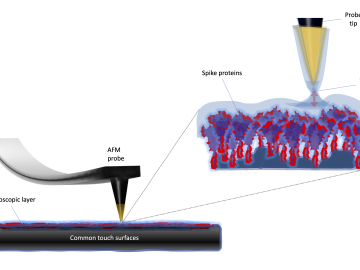
Filter News
Area of Research
- Biology and Environment (4)
- Building Technologies (1)
- Computational Biology (1)
- Computational Engineering (2)
- Computer Science (4)
- Energy Science (24)
- Fusion and Fission (3)
- Isotopes (13)
- Materials (8)
- Materials for Computing (12)
- Mathematics (1)
- National Security (3)
- Neutron Science (6)
- Quantum information Science (2)
- Supercomputing (17)
- Transportation Systems (1)
News Topics
- (-) Computer Science (76)
- (-) Cybersecurity (5)
- (-) Isotopes (29)
- (-) Microscopy (14)
- (-) Physics (12)
- (-) Polymers (10)
- (-) Transportation (36)
- 3-D Printing/Advanced Manufacturing (56)
- Advanced Reactors (7)
- Artificial Intelligence (52)
- Big Data (33)
- Bioenergy (29)
- Biology (45)
- Biomedical (23)
- Biotechnology (15)
- Buildings (42)
- Chemical Sciences (37)
- Clean Water (14)
- Composites (17)
- Coronavirus (10)
- Critical Materials (11)
- Education (2)
- Emergency (3)
- Energy Storage (36)
- Environment (77)
- Exascale Computing (27)
- Fossil Energy (4)
- Frontier (25)
- Fusion (20)
- Grid (26)
- High-Performance Computing (64)
- Hydropower (1)
- ITER (6)
- Machine Learning (24)
- Materials (56)
- Materials Science (48)
- Mathematics (8)
- Mercury (3)
- Microelectronics (2)
- Molten Salt (1)
- Nanotechnology (12)
- National Security (41)
- Neutron Science (43)
- Nuclear Energy (21)
- Partnerships (29)
- Quantum Computing (25)
- Quantum Science (34)
- Security (11)
- Simulation (24)
- Space Exploration (7)
- Statistics (4)
- Summit (23)
Media Contacts

A discovery by Oak Ridge National Laboratory researchers may aid the design of materials that better manage heat.

A study by Department of Energy researchers detailed a potential method to detect the novel coronavirus

Energy Secretary Jennifer Granholm visited ORNL on Nov. 22 for a two-hour tour, meeting top scientists and engineers as they highlighted projects and world-leading capabilities that address some of the country’s most complex research and technical challenges.

Oak Ridge National Laboratory has released the federal government’s new 2022 Fuel Economy Guide. The report provides the latest fuel efficiency stats and money-saving tips for new and used vehicles.

In experiment after experiment, the synthetic radioisotope actinium-225 has shown promise for targeting and attacking certain types of cancer cells.

Ten scientists from the Department of Energy’s Oak Ridge National Laboratory are among the world’s most highly cited researchers, according to a bibliometric analysis conducted by the scientific publication analytics firm Clarivate.

A team of collaborators from ORNL, Google Inc., Snowflake Inc. and Ververica GmbH has tested a computing concept that could help speed up real-time processing of data that stream on mobile and other electronic devices.

The U.S. Department of Energy’s Office of Science announced allocations of supercomputer access to 51 high-impact computational science projects for 2022 through its Innovative and Novel Computational Impact on Theory and Experiment, or INCITE, program.

Researchers at ORNL designed a novel polymer to bind and strengthen silica sand for binder jet additive manufacturing, a 3D-printing method used by industries for prototyping and part production.

A team including researchers from the Department of Energy’s Oak Ridge National Laboratory has developed a digital tool to better monitor a condition known as Barrett’s esophagus, which affects more than 3 million people in the United States.


